Since its inception in 1995, JavaScript has gained massive popularity in the development community. As per Stackoverflow Developer Survey, JavaScript is the most popular programming, scripting, and markup language with a 65.36% vote share.
With advancements in the development process and technology, new JavaScript frameworks are being developed more than ever. Having said that, the development community is always curious to know which ones are the best JavaScript frameworks. In this article, we’re going to discuss the top 15 JavaScript frameworks of 2024 along with their pros, cons, use cases, and everything else you need to know.
Top 15 JavaScript frameworks of 2024
Front-end JavaScript frameworks
1. Vue.js
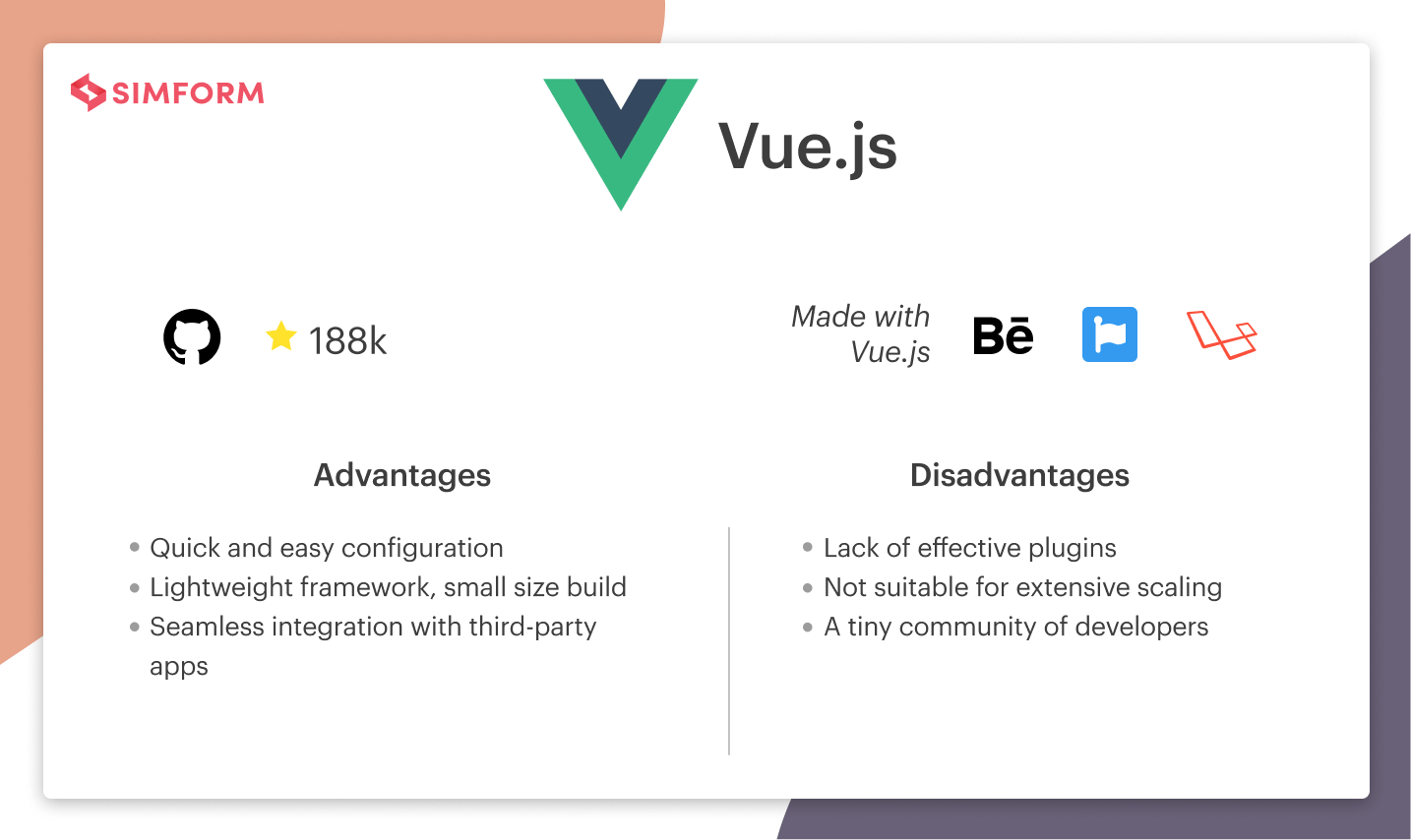
Developed in 2016, Vue.js is one of the most versatile front-end JavaScript frameworks. It’s also known as a progressive framework due to its capability to facilitate the design of high-end single-page web applications through dual integration mode. The framework follows the MVMM (Model-View-ViewModel) architecture pattern. Besides that, Vue.js is simple, unrestricted, and an easy-to-adopt framework.
Features:
- Two-way data binding
- Built-in component for CSS transitions and animations
- Provides HTML templates to bind the DOM with Vue.js instances
- Simpler in terms of API and design
- Comes with plenty of reusable components
Pros:
- Quick and easy configuration due to MVVM architecture
- Easy to learn, use, and understand even for beginners
- Lightweight framework with a small build size
- Seamless integration with third-party apps
- It comes with a virtual DOM option
Cons:
- Lack of high-end and effective plugins
- Not suitable for extensive scaling
- Older versions of iOS and Safari browsers can cause problems
- Difficulty with two-way binding
- Excessive flexibility can lead to fatal errors
2. React

React is one of the finest front-end open-source JavaScript frameworks that allow developers to create rich user interfaces. Created by a team of Facebook developers, React introduced functional, declarative, and component-based styles. In addition, React for web development ensures high-speed renders using virtual DOM. Furthermore, React is a complex framework for new developers to learn, use, and understand, but it has an extensive community.
Features:
- Fully compatible W3C model event system
- Has a Virtual DOM
- Follows component-based architecture
- Faster debugging and processing
- Declarative UI that makes the code more readable
Pros:
- Plenty of reusable components to build business logic
- Ease of integration with front-end and back-end
- Unidirectional data flow with flux controls
- SEO-friendly JavaScript framework
- Huge support community
Cons:
- Only covers the UI layer of the app
- Have to deal with complex state management
- Constant upgrades make it difficult for developers to keep up with the changes
- New developers may find JSX to be a barrier
- It doesn’t use an isomorphic JavaScript code
3. Angular
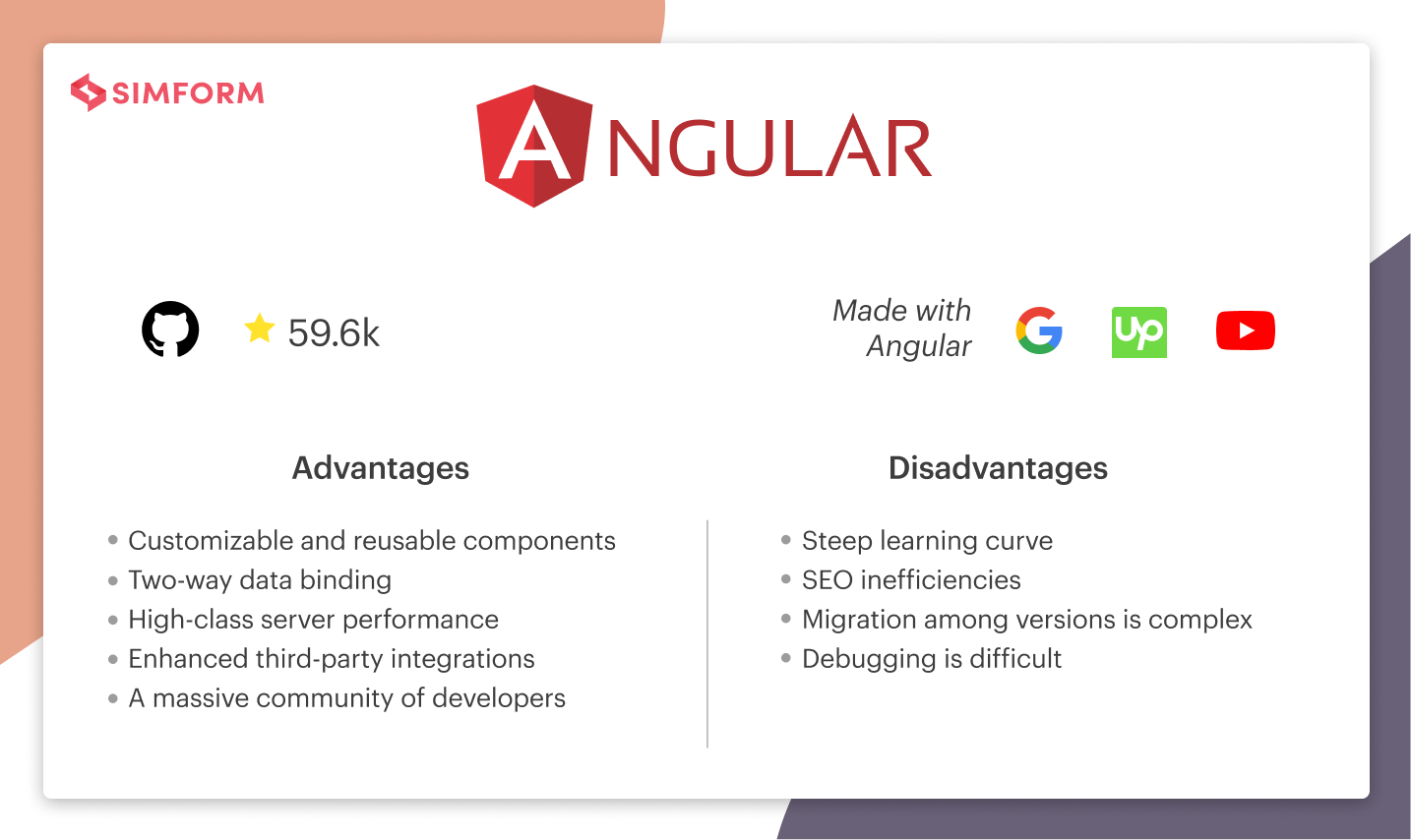
Angular: Typescript-based JS framework
Angular was born after a complete rewrite of Misko Hevery’s AngularJS in 2016 at Google. It is a Javascript framework that enables the development of scalable web apps. In addition, Angular allows the reuse of codes across several deployment targets.
Further, users can establish bi-directional communication through Angular’s two-way data binding attribute. It allows users to exchange data between components and views, both ways. Angular enables the development of classy single-page applications through component-based architecture and tree-view structure.
Features:
- Turns templates into highly optimized code for JVM
- Allows you to develop PWA (Progressive Web Application)
- Follows the MVC (Model-View-Controller) architecture pattern
- Facilitates easy building, adding, and testing of components with Angular CLI
- Cross-browser compatibility
Pros:
- Customizable and reusable components
- Two-way data binding
- High-class server performance
- Enhanced third-party integrations
- A massive community of developers
Cons:
- Steep learning curve
- SEO inefficiencies
- Migration among versions is complex
- Debugging is difficult
4. Svelte JS
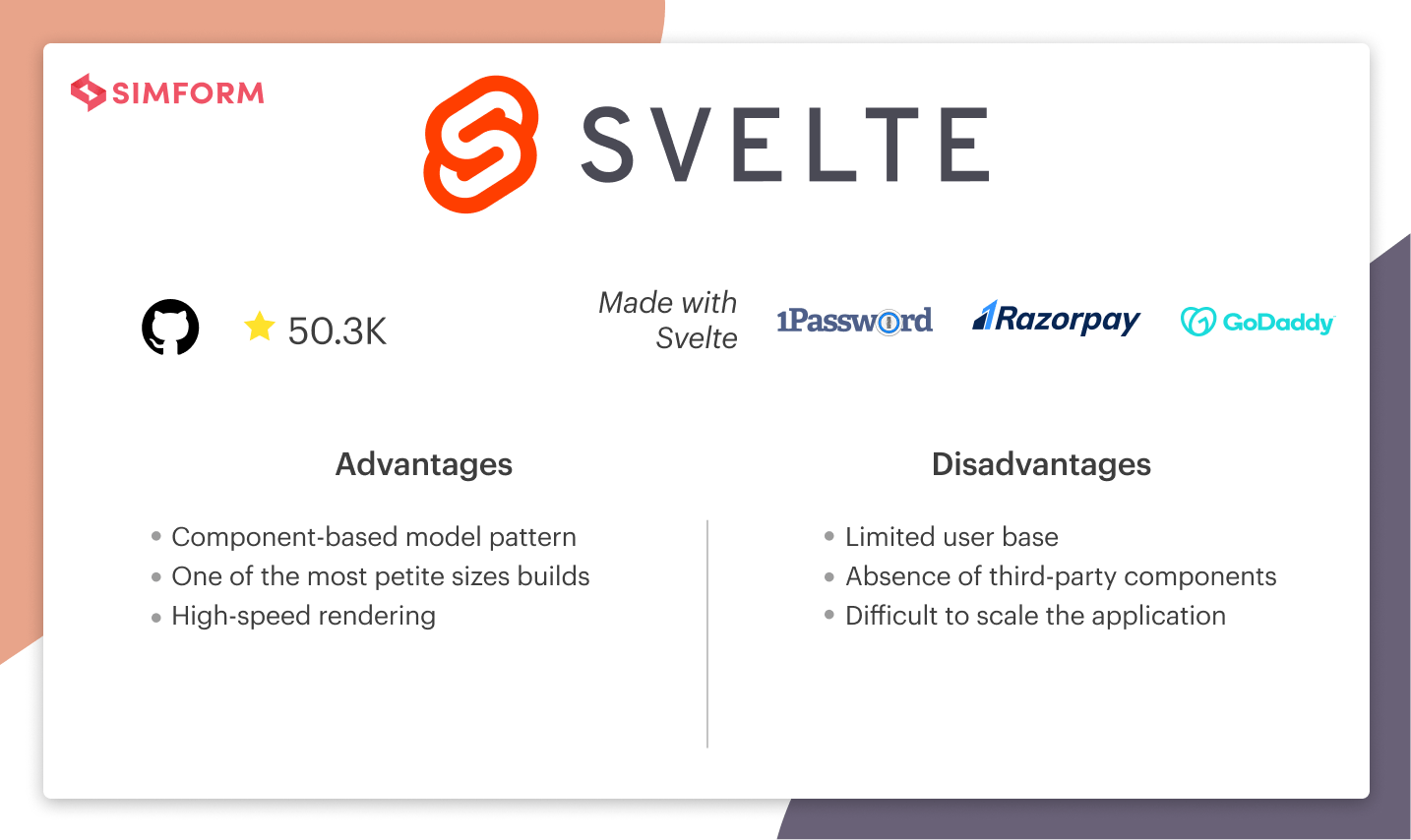
Svelte JS is an open-source, web component-based front-end development framework written in Typescript. Launched in 2016, Svelte JS has made quite a reputation among programmers. Svelte JS builds the boilerplate code in HTML, CSS, and JS and therefore, it can develop web applications in a revolutionary manner unlike Vue.js or React, where you have a virtual DOM. One great thing about Svelte is that it doesn’t require high browser processing.
Features:
- Has a simple state management system
- Concise code and lightweight files
- Built-in tools for effects and animation
- Works as a disappearing framework
- Comes with plenty of ready-to-use components
Pros:
- Component-based model pattern
- Easy to use, learn, and understand
- One of the most small-sized builds
- High-speed rendering and top-notch performance
- Supports both client and server-side rendering
Cons:
- Not much IDE support available in the market
- Doesn’t have the backing of tech giants like Vue, Angular, and React
- Absence of third-party components
- Difficult to scale up the application
- Inefficient tooling for debugging apps
5. Preact JS
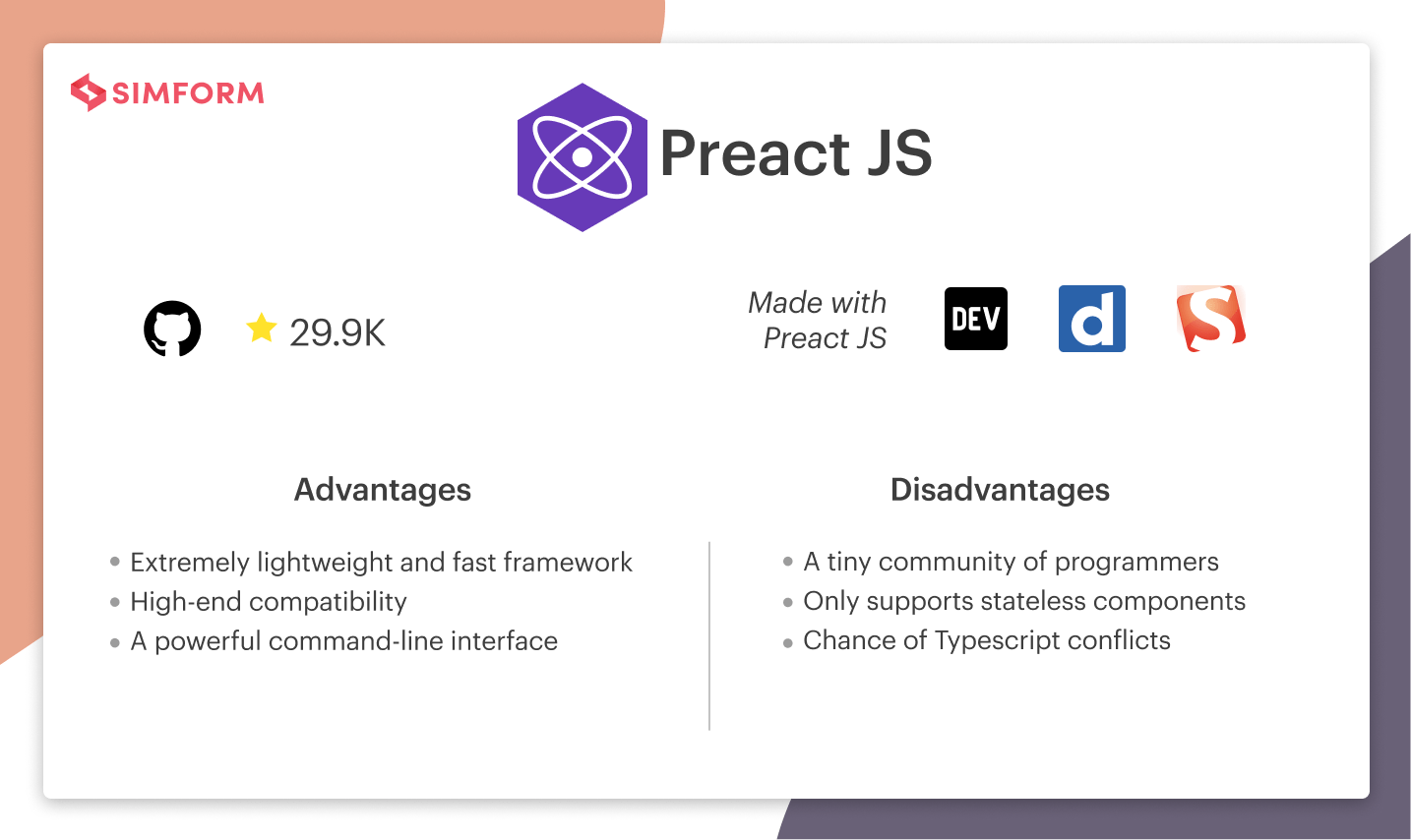
Preact JS is one of the lightweight, swift, and best-performing JavaScript libraries that can be a great alternative to React. Preact JS is a minified version of React with a 3KB built size but covers all the core functionalities of a JavaScript framework. Many developers use React for development and switch to Preact at the time of production. With strong community support, fast performance, and clean programming Preact JS has made a name for itself in the community.
Features:
- Rapid performance and high-speed processing
- Highly portable and embeddable framework
- Reusable and compatible with other ecosystems
- Extremely tiny code size
- Allows you to use components available within React ecosystem
Pros:
- Extremely lightweight and fast framework
- High efficiency compared to React
- High-end compatibility
- A powerful command-line interface
- Presence of link-state module
Cons:
- A small community of programmers compared to React
- Only supports stateless components
- It doesn’t support propTypes, a key feature of React
- Chance of Typescript conflicts
- Large and complex codebase
6. Backbone.js
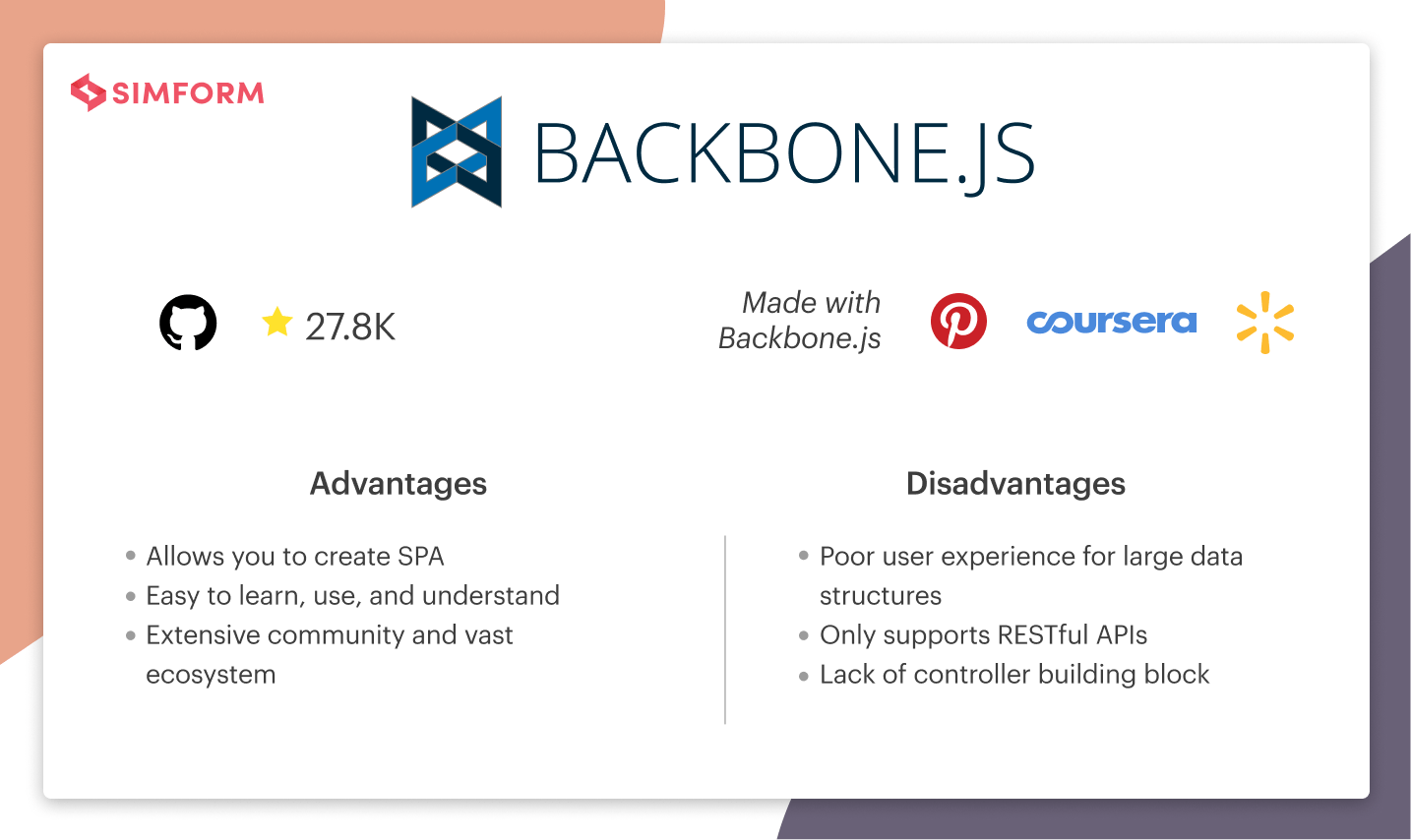
Backbone.js is one of the most popular JS libraries and is easy to use, learn, and understand, even for beginners. Developers nowadays use Backbone.js to create single-page web applications. The primary aim behind the development of Backbone.js was to reduce the complexity of programming and achieve advanced-level functionalities with lesser coding. For that purpose, the framework makes sure that all the server-side functions are flowing through API.
Features:
- Provides plenty of ready-to-use components
- Free and open-source library with 100+ extensions=
- Helps in separating business and UI logic
- Clear, readable, and comprehensive documentation
- Simple, systematic, and organized source code
Pros:
- Allows you to create SPAs (Single Page Applications)
- Requires less coding
- Easy to learn, use, and understand
- Provides structure with key-value binding and custom events
- Extensive community and vast ecosystem
Cons:
- Improper model definition
- Poor user experience for large data structures
- Only supports RESTful APIs
- Testing can be difficult
- Lack of controller building block
7. Ember.js
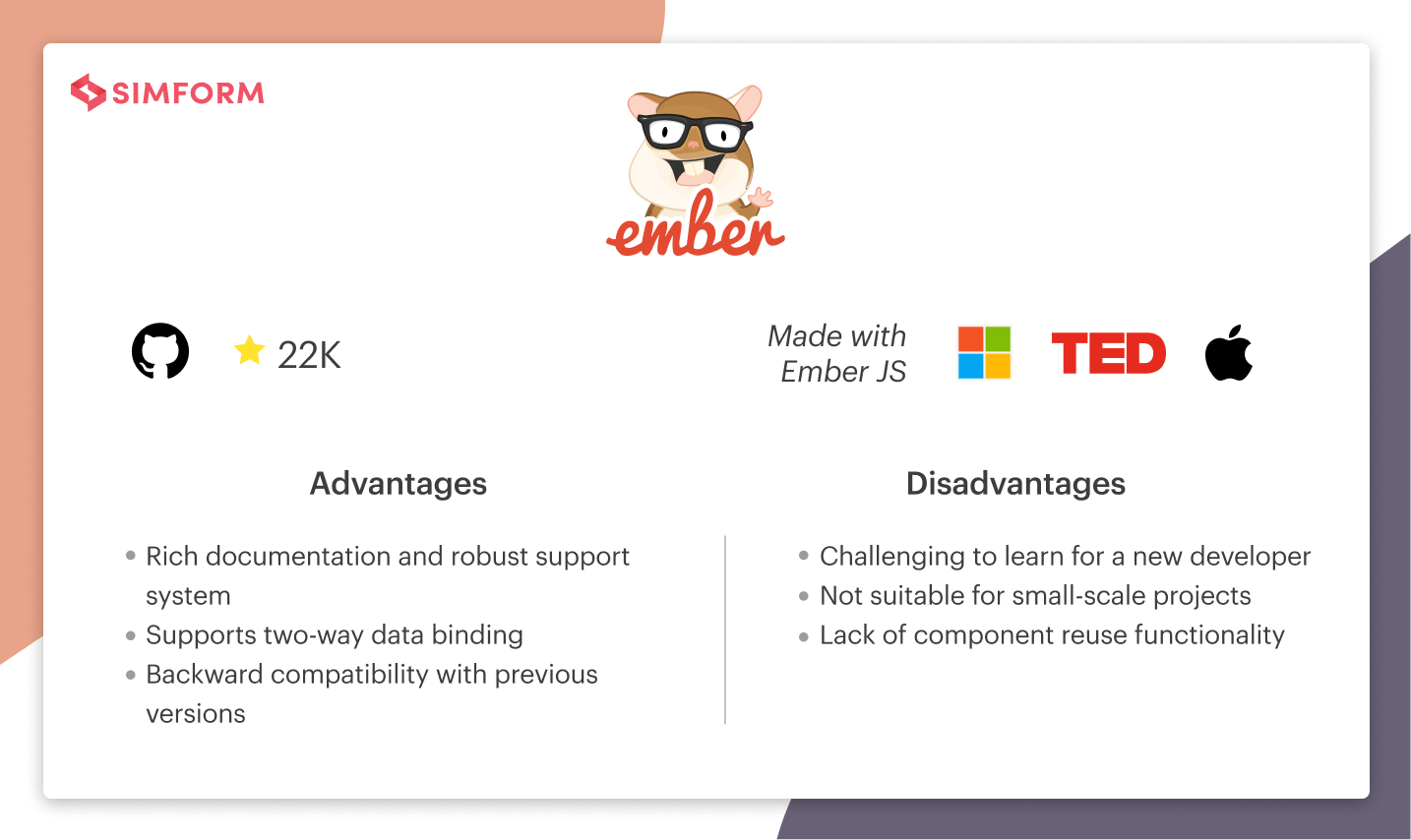
Ember.js is one of the most fascinating front-end JavaScript frameworks. Developers use it to create high-end and scalable enterprise-level applications. Like Vue.js, Ember.js also follows the MVVM (Model-View-ViewModel) architecture pattern. The USP of Ember.js is the command-line interface tool that makes it a productivity powerhouse. Although Ember.js is an old-age JavaScript framework, it still packs a punch with handlebars templating language.
Features:
- Allows you to create reusable and maintainable web applications
- Uses a template to update the model automatically
- Automatically determines routes and controls
- Facilitates declaring functions as properties with computed properties
- Provides an in-built debugging tool for inspecting applications
Pros:
- Provides a great mechanism to work with APIs
- Rich documentation and robust support system
- Supports two-way data binding
- Backward compatibility with previous versions
- Follows convention over configuration pattern
Cons:
- Challenging to learn for a new developer
- Decreasing popularity in the last few years
- Not suitable for small-scale projects
- Lack of component reuse functionality
- A cumbersome size built for debugging
8. Polymer
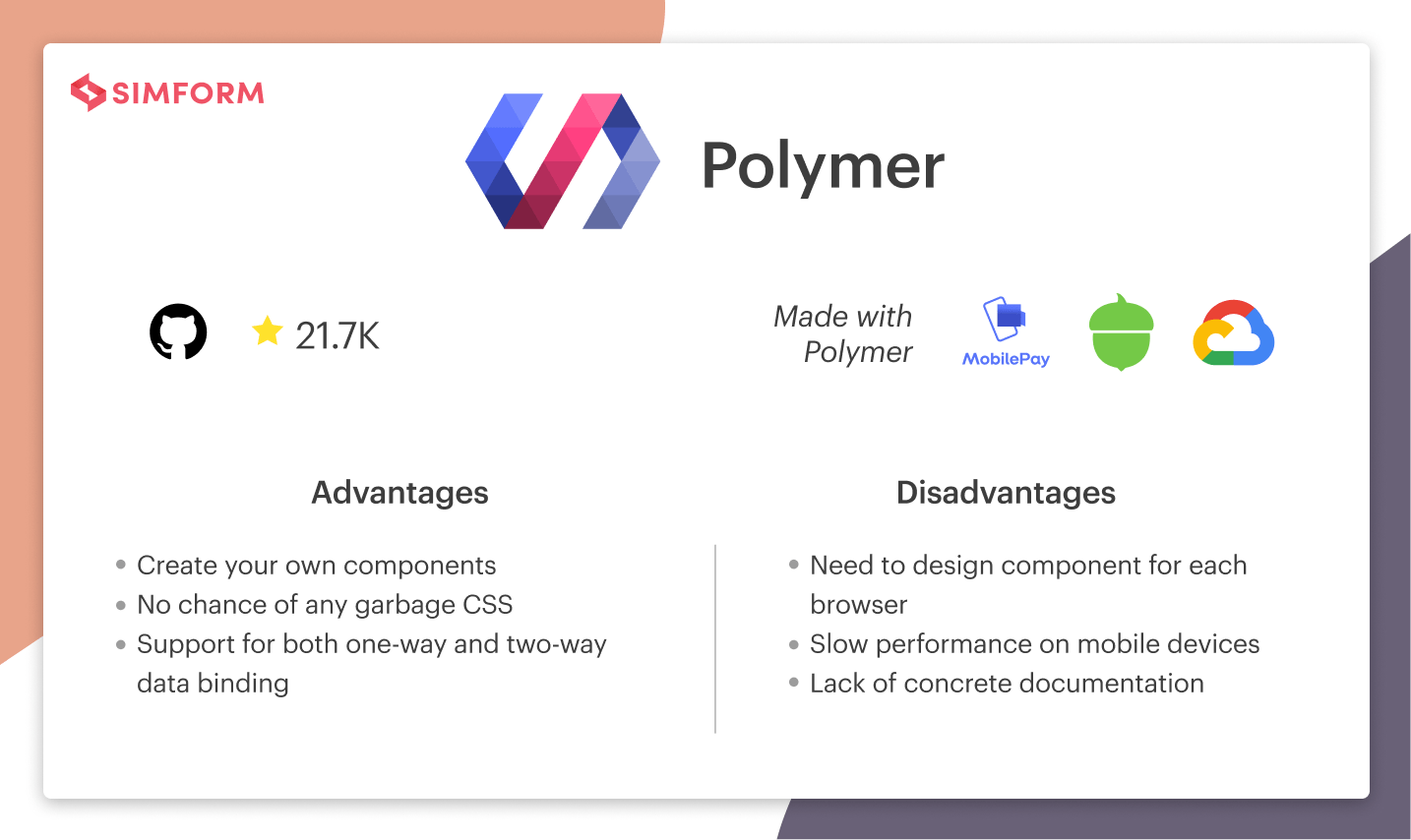
Developed by Google, Polymer is an open-source JavaScript library that enables developers to create elegant websites and web applications. The front-end framework supports both one-way and two-way data binding, and thus you can have an all-inclusive kind of application. Furthermore, Google has designed Polymer to use existing web components to build any web application, making it the USP of this core library.
Features:
- Allows you to create customized HTML elements
- Facilitates the development of reusable widgets
- Uses Google Material Design for easy hybrid mobile application development
- Enables importing and using external components
- Provides command line interface for managing projects
Pros:
- Allows you to create your components
- Provides you the facility to develop high-end UX
- No chance of any garbage CSS
- Support for both one-way and two-way data binding
- Responsive design using app layout components
Cons:
- Need to design component for each browser
- Slow performance on mobile devices
- Inadequate or confusing error reporting
- A lot of issues related to library dependencies
So far, we have provided you with a list of JavaScript frameworks for the front-end. Now, it’s time to analyze the JavaScript back-end frameworks for 2024.
Back-end JavaScript frameworks
9. Node.js
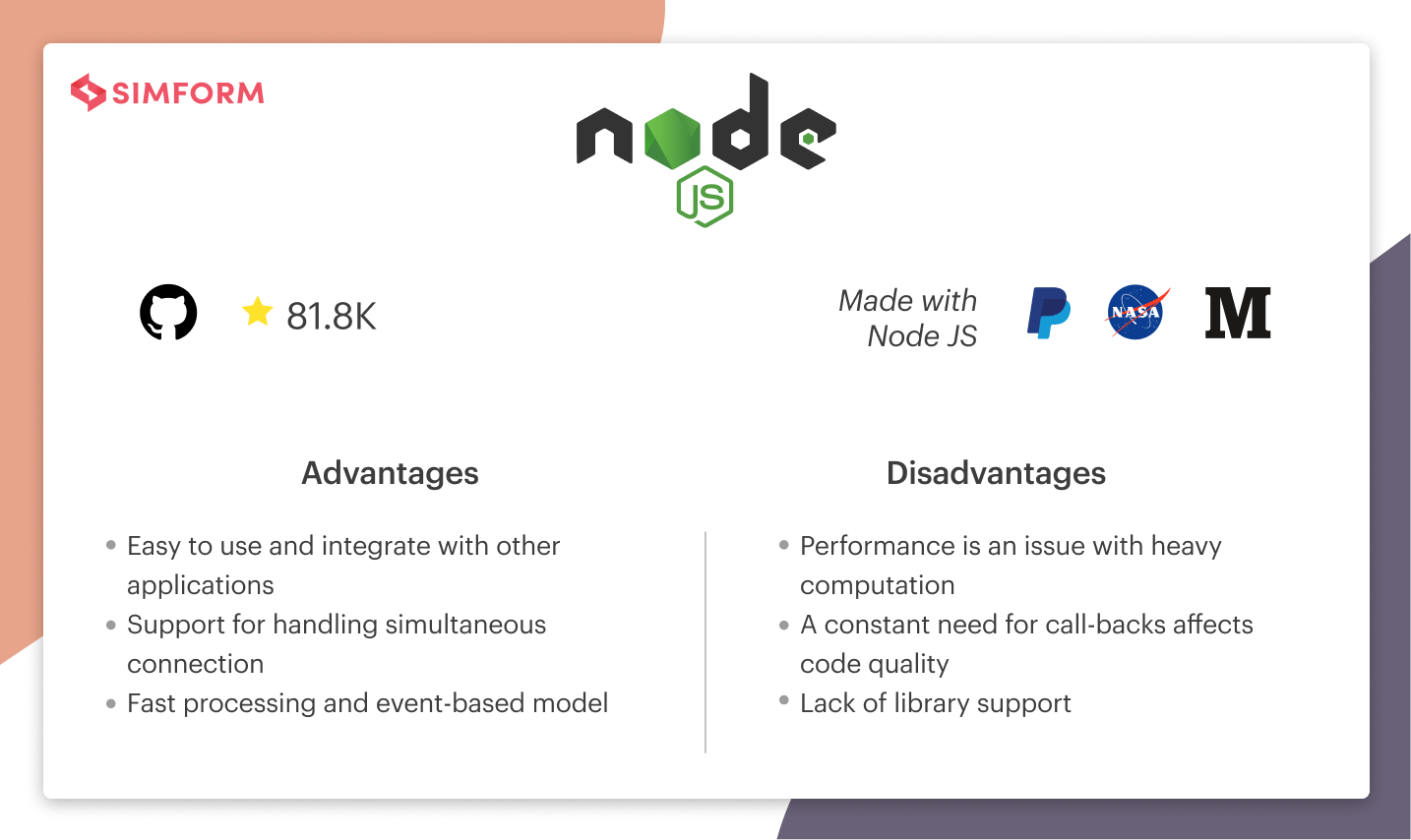
Node.js is a server-side JavaScript runtime environment built on the V8 engine under MIT license. The backend architecture pattern of Node.js enables developers to use it on both the client-side and server-side. The open-source and asynchronous nature of Node.js makes it an ideal choice for event-driven development. The framework works in the JavaScript runtime environment; it exhibits all the core features of Java-like threading, packing, forming loops, etc.
Features:
- Facilitates code reusability between client and server sides
- Can be used as a proxy server
- Compatible with various libraries and web frameworks
- Built on the Google Chrome V8 engine, which makes code execution easier
- Comes with NPM (Node Package Manager), the world’s largest repository of packages
Pros:
- Easy to use and integrate with other applications
- Ability to scale up as per the requirements
- Asynchronous and non-blocking thread execution
- Support for handling plenty of simultaneous connection
- Fast processing and event-based model
Cons:
- Performance is an issue with heavy computation
- Outdated tooling ecosystem a huge concern
- A constant need for call-backs affects code quality
- Lack of library support
- Invites a lot of changes due to unstable API
10. Next JS
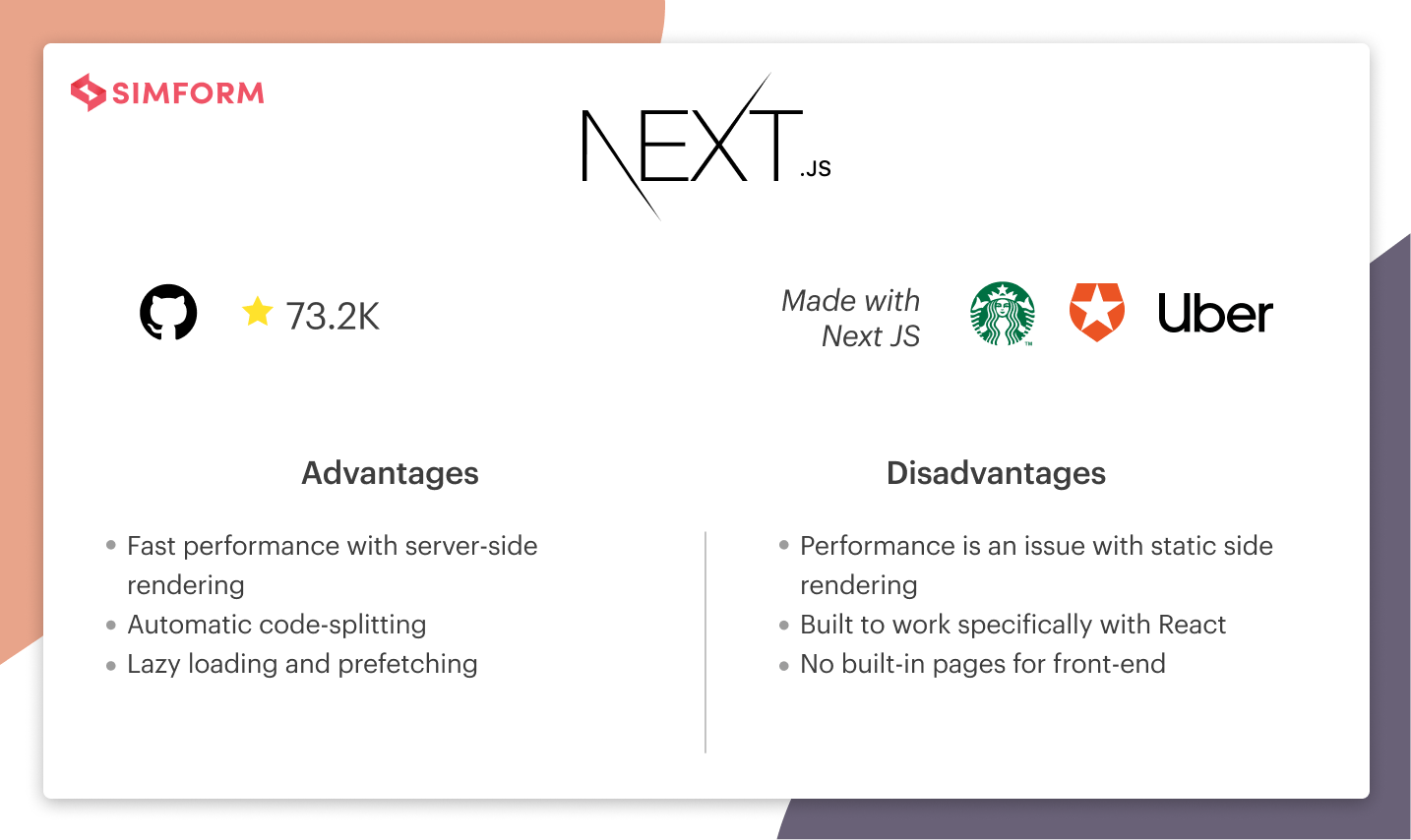
Next JS is a server-side rendering framework based on React.js and is highly popular as a backend framework among the software development community. The framework takes its basis on the principle of “Build Once, Run Everywhere,” which allows you to develop both web and mobile applications. In addition to that, Next JS also provides support for creating Progressive Web Apps (PWA). Lastly, the framework helps you to address SEO-related issues.
Features:
- Page-based routing system
- Built-in support for CSS and Sass
- Supports both static generation and server-side rendering
- Allows you to import JavaScript modules dynamically
- Cross-browser compatibility
Pros:
- Fast performance with server-side rendering
- The ability of automatic code-splitting
- Allows lazy loading and prefetching
- Facilitates hot code reloading
- SEO-friendly back-end framework
Cons:
- Performance is an issue with static side rendering
- Requires back-end server to load data
- Built to work specifically with React
- Lack of high-end plugins
- No built-in pages for front-end
11. Express JS
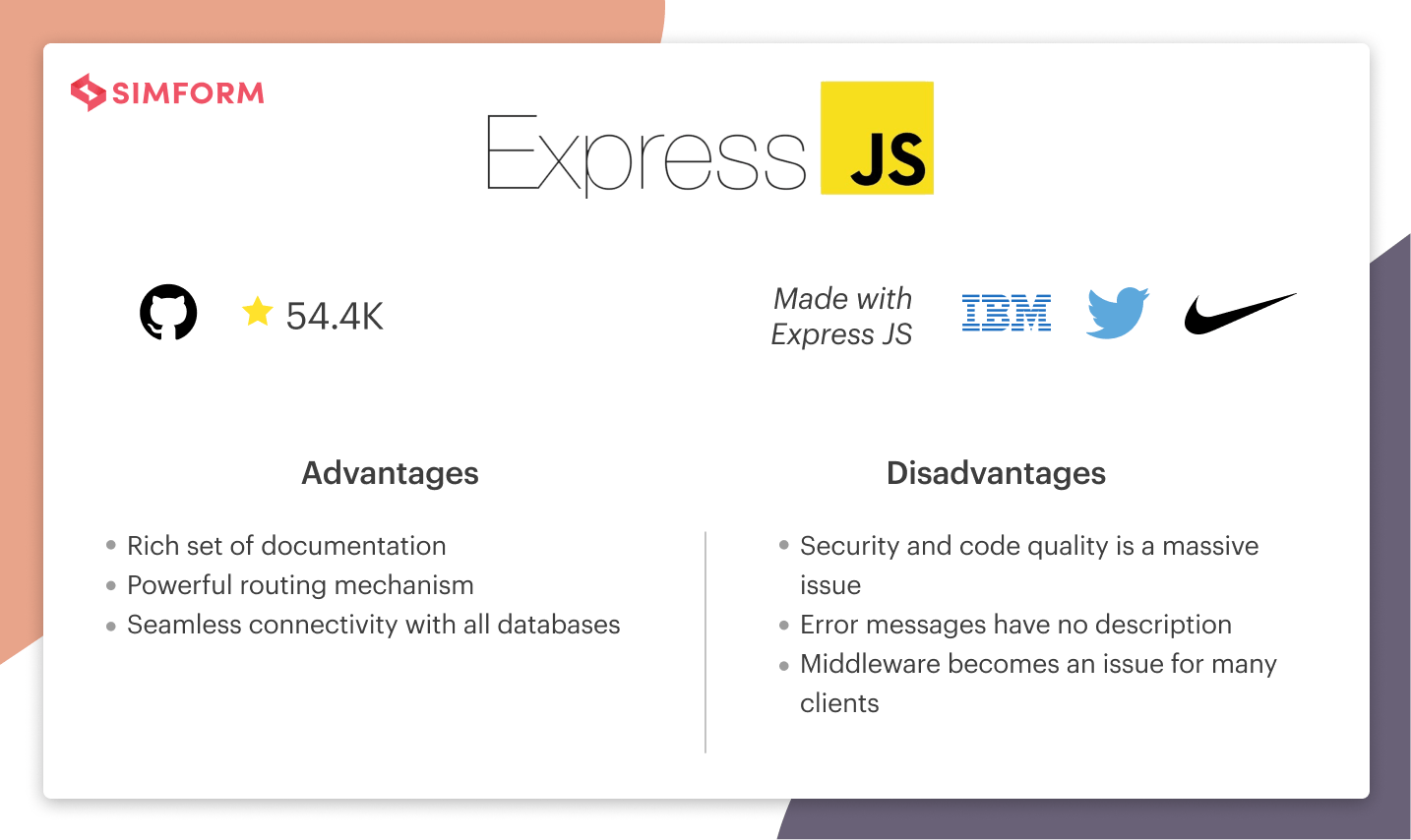
Express JS is an open-source and minimalistic back-end JavaScript framework based on Node.js that developers use to build complex APIs and web applications. The framework has gained massive popularity in recent years, and due to that, it has become the first choice when using the MEAN or MERN stack. The USP of Express JS is its rapid server-side coding ability, and it enables web application developers to complete any complex task within a matter of minutes.
Features:
- Dynamically renders HTML pages based on passing arguments
- Used to design single-page, multi-page, and hybrid web applications
- Enables setting up middleware to respond to HTTP requests
- Provides templating engine to build dynamic web pages
- Comes with an in-built debugging facility
Pros:
- Active community support
- Rich set of documentation
- Powerful routing mechanism
- Seamless connectivity with all databases
- Accelerates web app development process
Cons:
- Security and code quality can be an issue
- Middleware creates issues for many clients
- Error messages have no description
- Hard to find an optimal way to write code for server-side
- Several issues in call-back
12. Gatsby JS
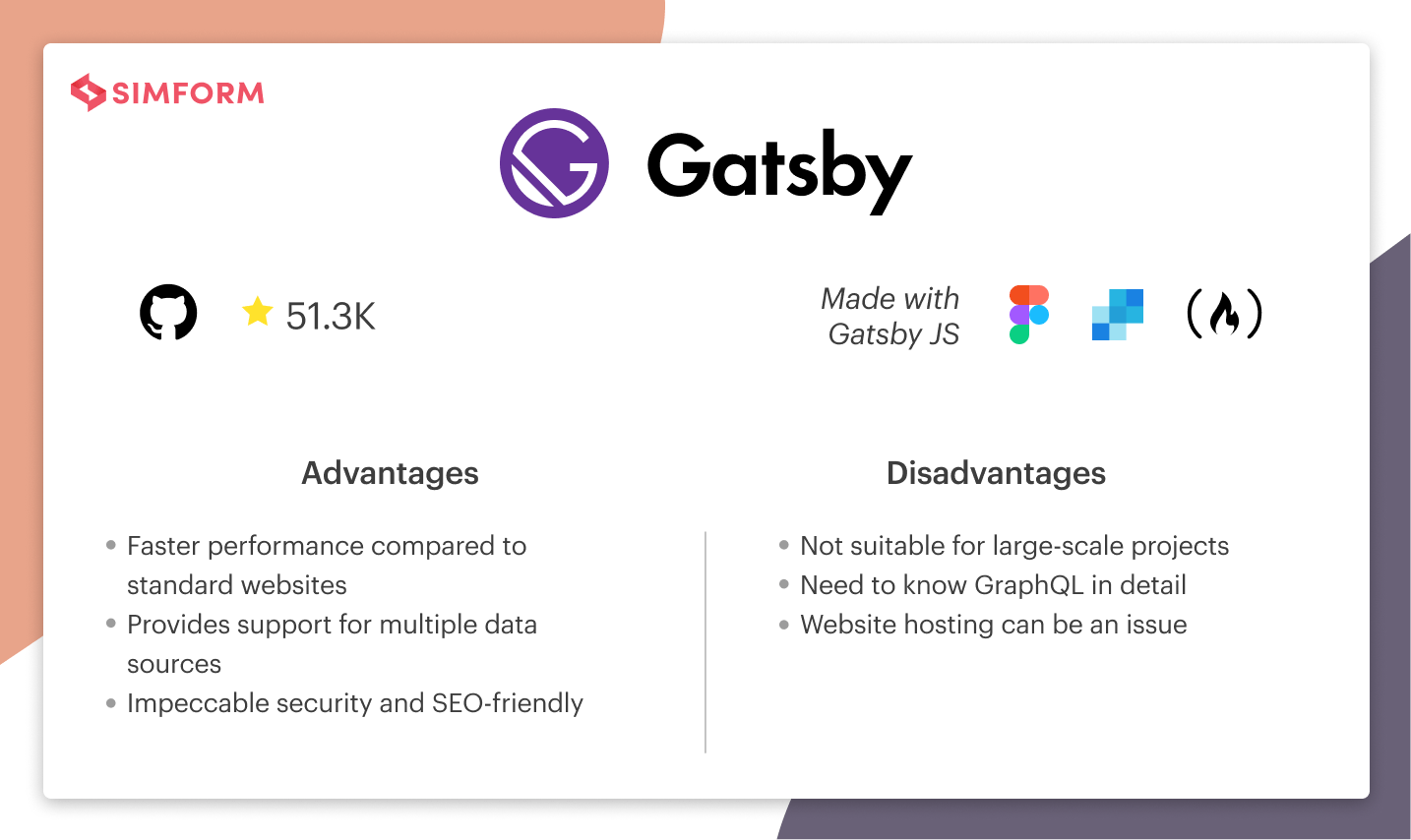
Gatsby JS is another star player when it comes to the best back-end JavaScript frameworks. Launched in May 2015, Gatsby JS is a modern, flexible, and GraphQL based static-site generator. It helps developers to build quality and SEO-friendly web applications. The framework doesn’t perform any server-side rendering; instead, it generates HTML code on the client-side during the build. Besides all of these aspects, Gatsby JS offers impeccable security.
Features:
- Allows you to write in JavaScript or SCSS or LESS
- Works seamlessly with various Content Delivery Networks (CDN)
- Comes with an extensive open-source ecosystem
- Rich and world-class documentation
- Offers scalable site hosting at lower rates
Pros:
- Faster performance compared to standard websites
- Allows you to build a high-end PWA
- Provides support for multiple data sources
- Impeccable security and SEO-friendly
- A rich and extensive set of plugins
Cons:
- Lack of WordPress-style plugins
- Demands in-depth knowledge of GraphQL
- Website hosting can be an issue
- Need to update content frequently as no clear previews like WordPress
- No plug-and-play functionality
13. Meteor
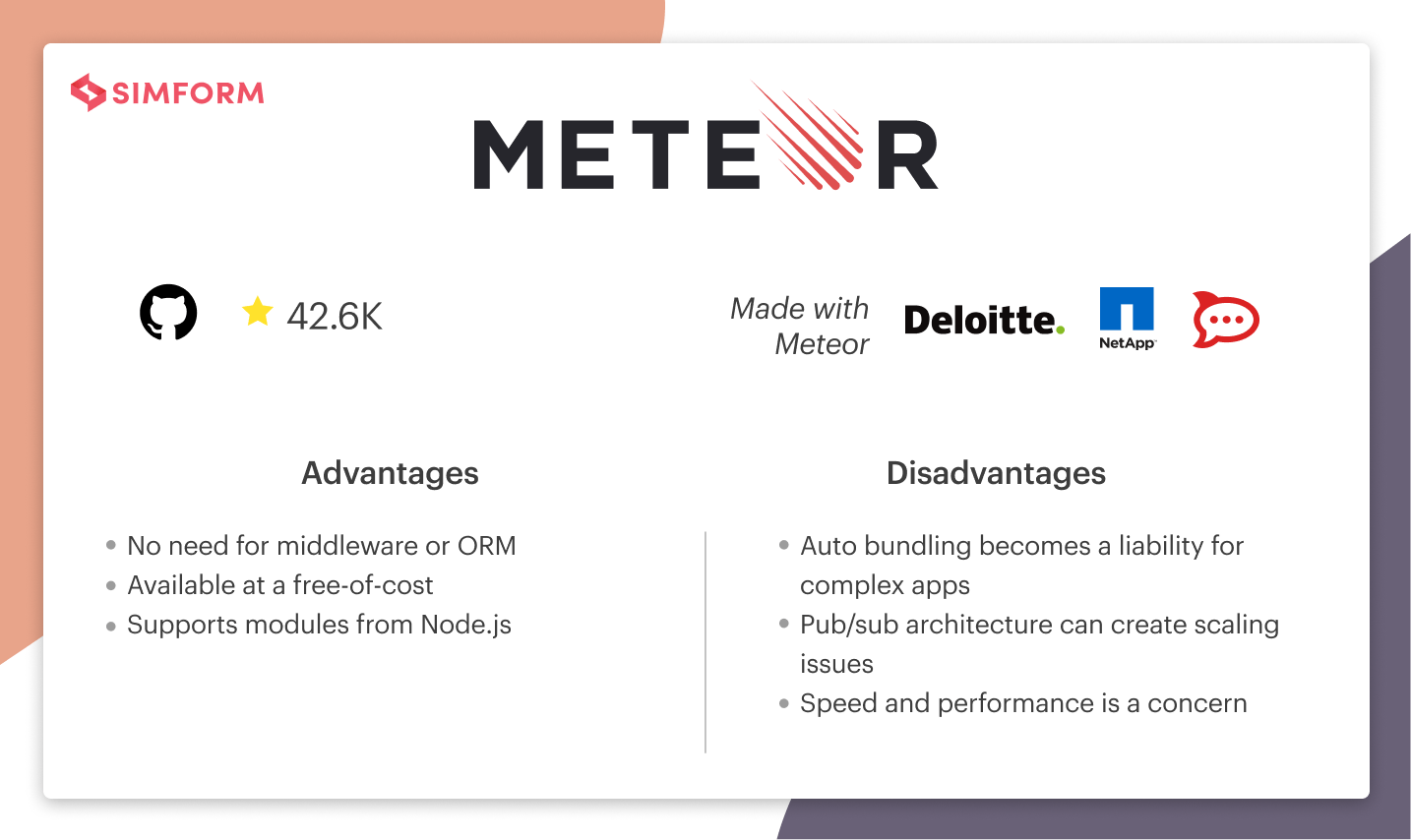
Meteor is a full-stack, open-source, and free back-end development framework written in Node.js. Whether it’s rapid prototyping or cross-platform code creation, Meteor is your one-stop solution for such functionalities. The framework can integrate with other JavaScript frameworks such as React, Express, and Angular. Furthermore, it can also incorporate MongoDB and Cordova to build hybrid apps. With Meteor, you have to code less as there are ample scaffolding, libraries, and packages readily available and it also allows automatic transmission of data changes.
Features:
- Hot reload and automatic CSS/JS modification
- Facilitates code reusability between web and mobile applications
- Supports any database with Node.js driver
- Comes with isomorphic JavaScript code
- Offers a custom package manager
Pros:
- No need for middleware or ORM
- Available for free
- Supports modules from Node.js
- A full-stack JavaScript framework
- Excellent framework to develop an MVP
Cons:
- Auto bundling becomes a liability for complex apps
- Pub/sub architecture can create scaling issues
- Speed and performance is a concern
- Unpredictable in development and deployment
- It can’t handle a vast amount of records
14. Nuxt JS
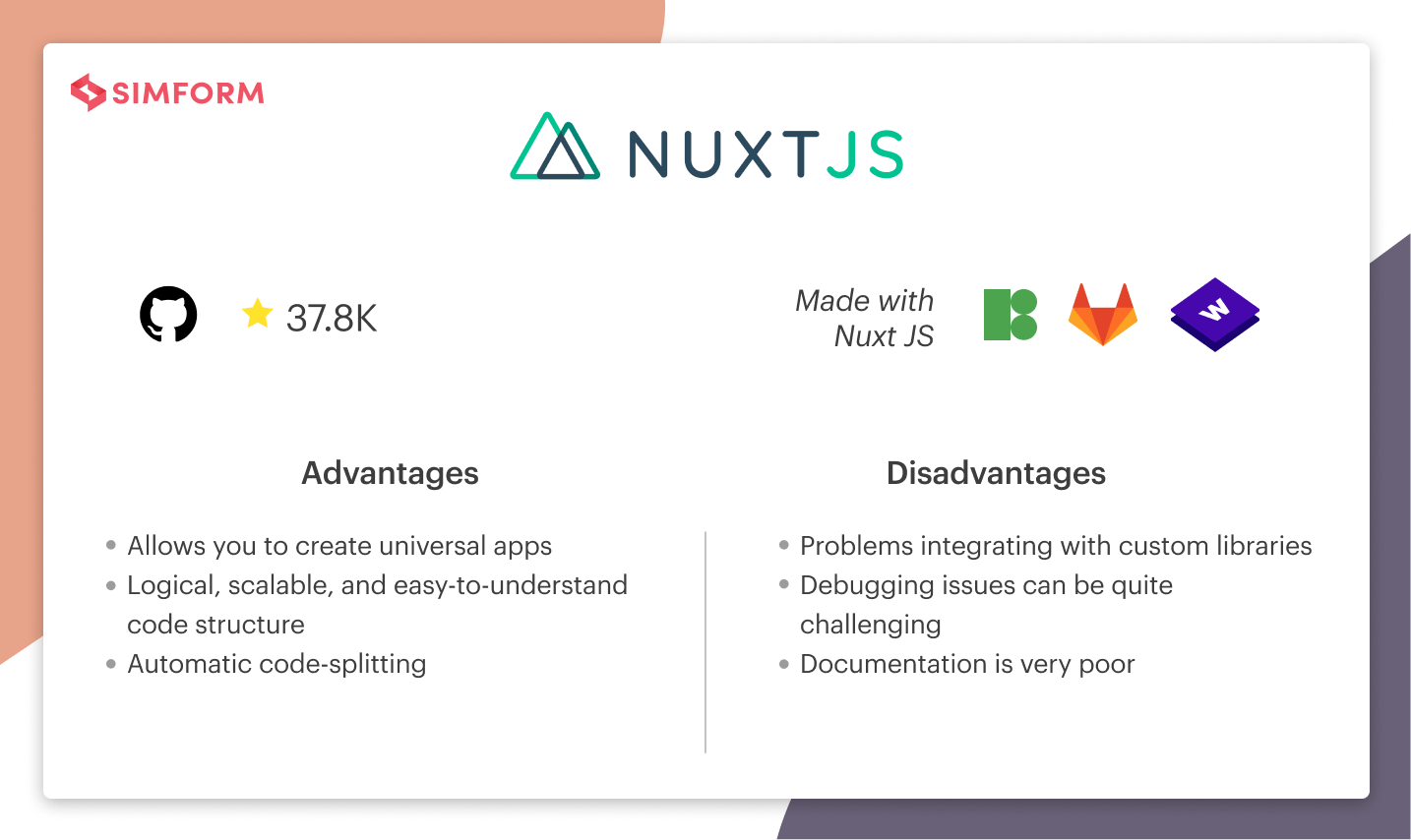
Nuxt JS is one of the most versatile and popular back-end JavaScript frameworks based on Vue.js. Developers use it to create high-performance server-side rendering apps. The framework also supports progressive web applications. Nuxt JS is not a replacement for Vue.js, but it enhances applications built with Vue.js. You can consider Nuxt JS as a combination of Vue.js libraries and components – Vue. Vuex, Vue Router, etc.
Features:
- Created using an adaptive modular architecture
- Provides exceptional support for SEO (Search Engine Optimization)
- Ability to switch between static-site generation and server-side rendering
- Comes with 160+ modules to enable faster development
- Robust routing system and modular architecture extension
Pros:
- Easy setup and configuration
- Allows you to create universal apps
- Logical, scalable, and easy-to-understand code structure
- Automatic code-splitting
- A rich collection of libraries and modules
Cons:
- Problems integrating with custom libraries
- Debugging issues can be quite challenging
- Handling high-traffic apps can be difficult
- Working with custom libraries can be challenging
- Lack of plugins
15. Jest
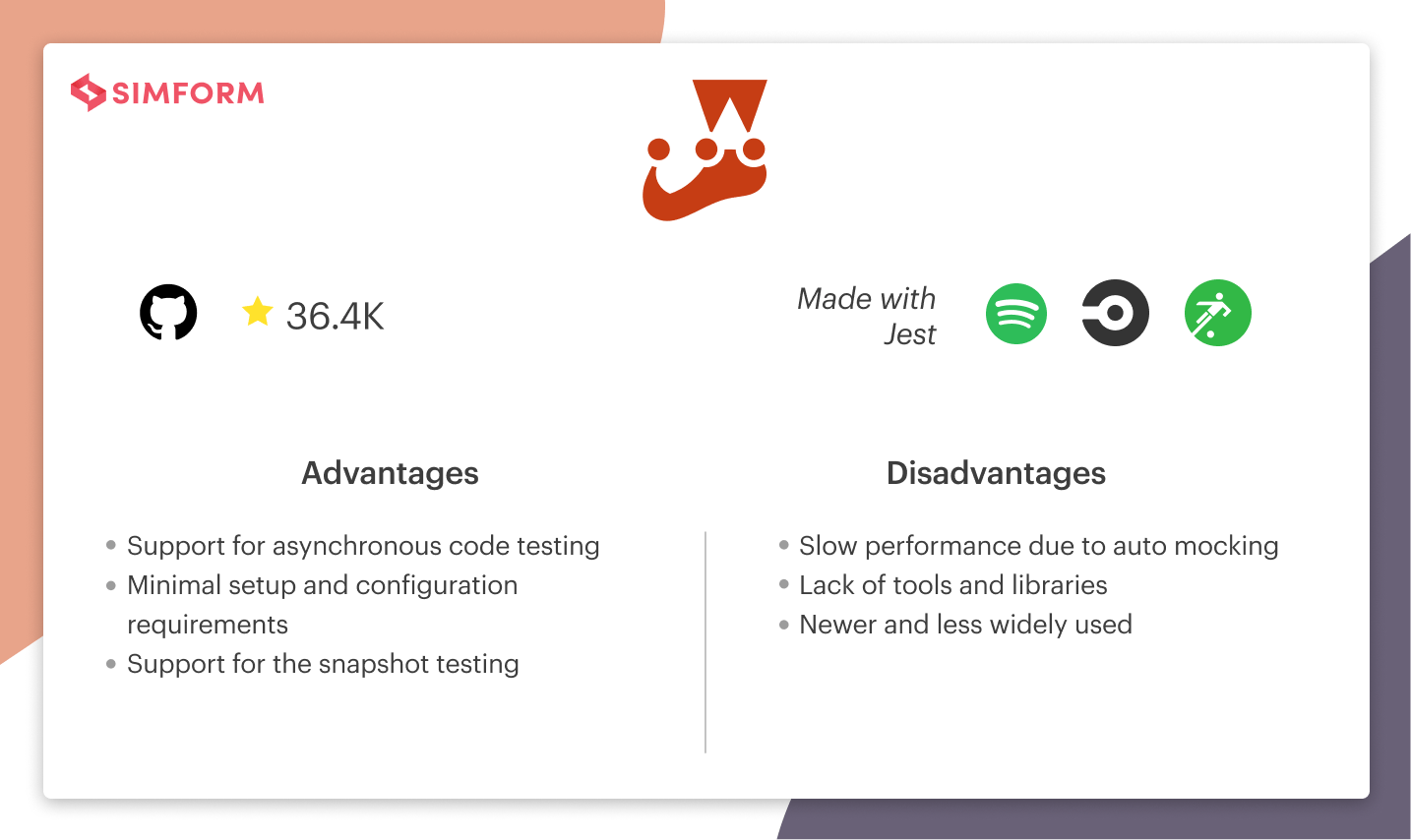
Jest is one of the most popular JavaScript back-end frameworks that developers use for web application testing. Developed by Facebook, Jest has gained popularity among developers in a brief period. The primary reason behind this is the simplicity that Jest brings with it. It’s easy to understand and developers can quickly and start using it after a few introductory training sessions. In addition to that, it provides you with cross-browser support for automated testing.
Features:
- Easy to setup, use, and understand, even for a newbie
- Allows isolated working of all tests in execution
- Offers cross-browser compatibility to test your software
- Support for mocking and TypeScript
- Enables you to conduct snapshot testing
Pros:
- Officially supported by React developer community
- Support for asynchronous code testing
- Support for visual regression testing
- Minimal setup and configuration requirements
- Well maintained and well documented
Cons:
- Slow performance due to auto mocking
- Have to use jasmine for effective execution
- Snapshot testing is not feasible
- Lack of tools and libraries compared to other testing frameworks
- An expensive JavaScript framework
Having detailed knowledge about various JavaScript frameworks is not enough to make a decision. One also needs to know how to choose the best JavaScript framework for your project and what to factor in while doing the analysis. So, let us focus on that aspect in the next section.
How to choose the best JavaScript framework for your project?
There is no one-size-fits-all kind of thing when choosing the proper JavaScript framework for your project. The project requirements vary from one to another and so, within that criteria, you need to find out the best possible option for your business.
Here is a list of various evaluation criteria that you can opt to choose one that fits into your requirements:
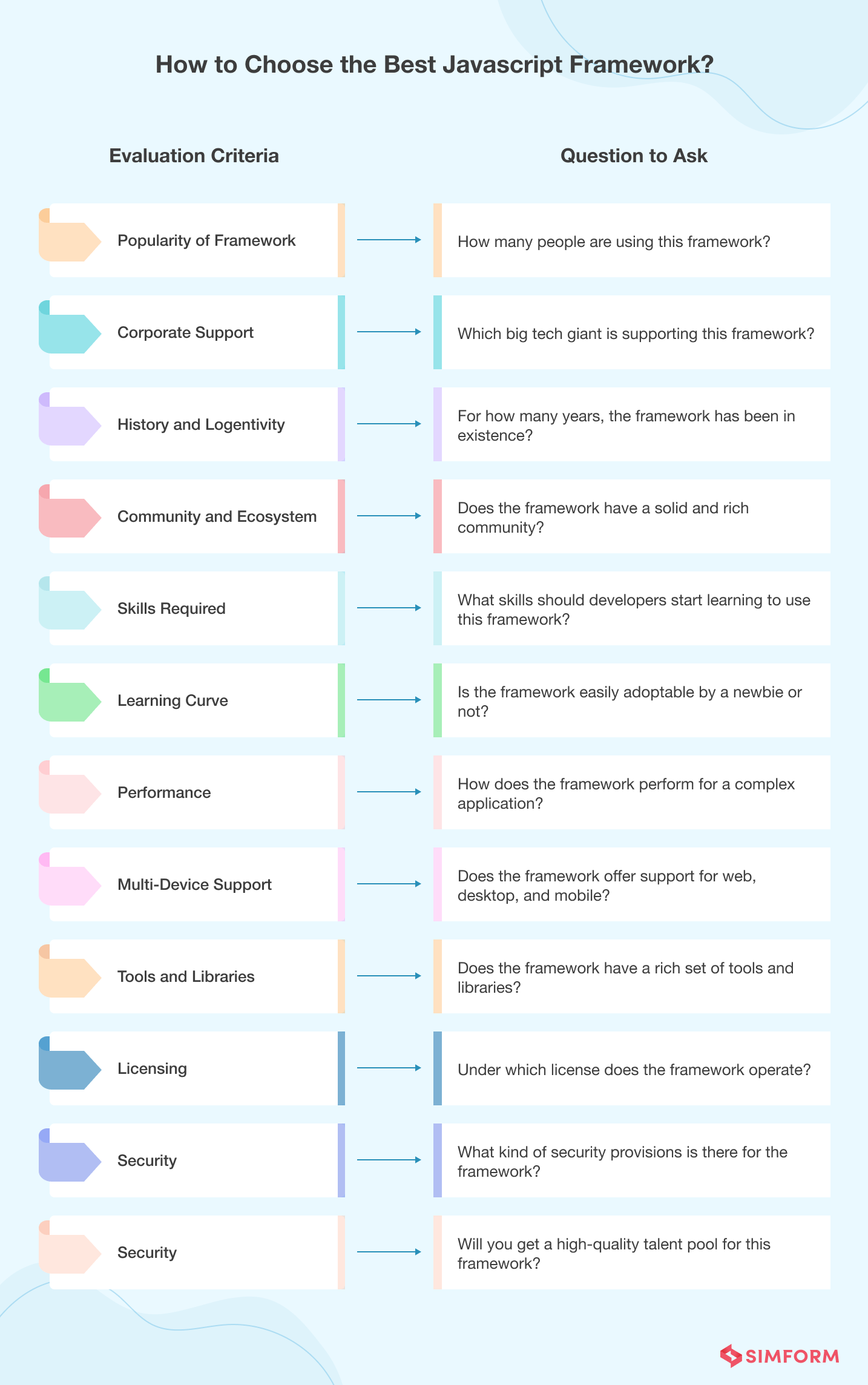
These are some of the questions you can ask before taking a final call regarding your JavaScript framework. It would help you to reach your destination with the utmost ease.
Bonus Infographic – The state of JavaScript frameworks
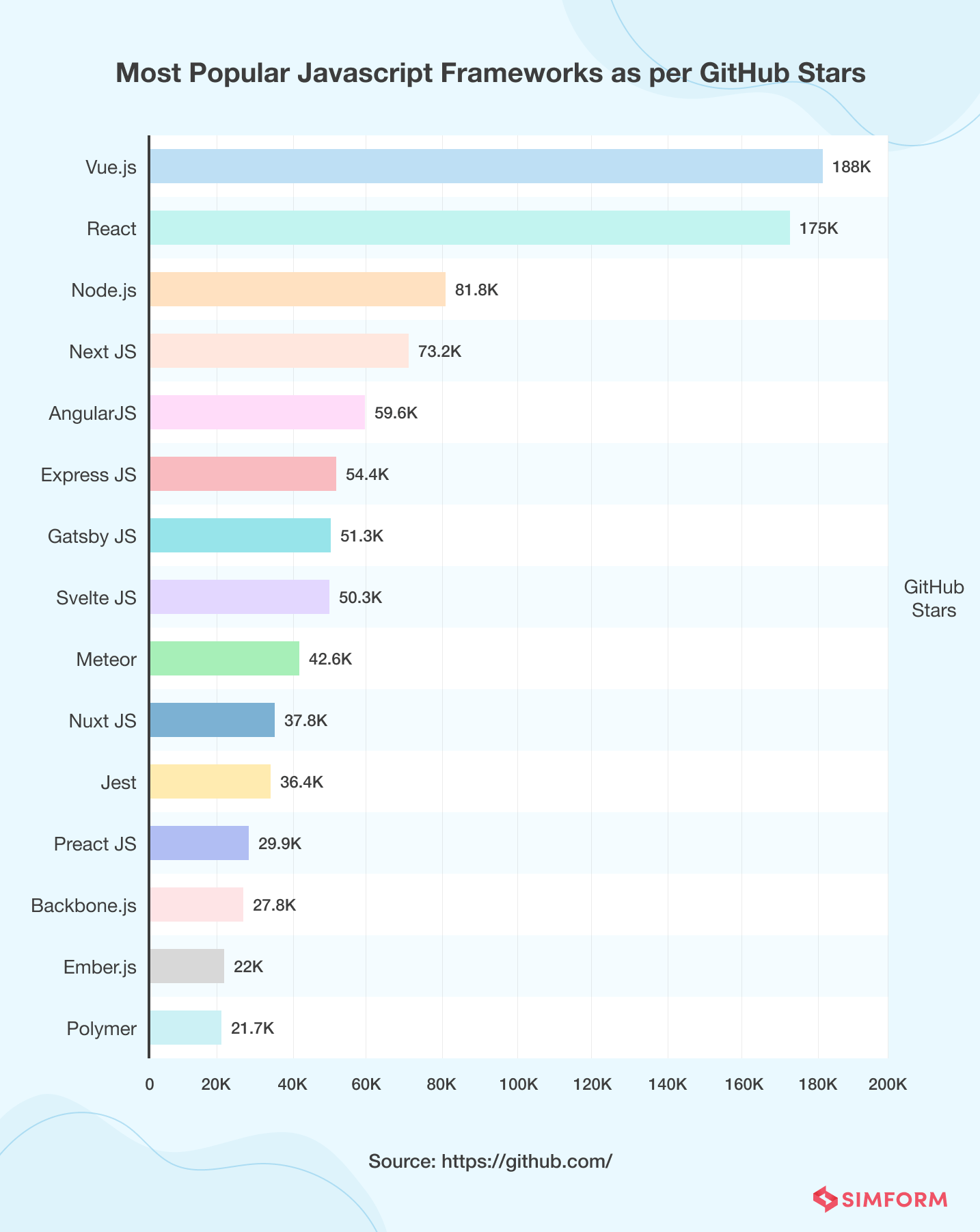
Conclusion
So far, you must have got an idea of which JavaScript framework is booming in the market and which one you should select for your specific project requirements. However, once you choose the ideal framework for your business, the game is not over. There are some steps you need to follow in order to utilize that framework for your business application.
You need to find a trustworthy technology partner who can help you develop a world-class web application using that framework. Simform is one of the leading software development companies helping people transform their businesses and elevate them to the next level. With a team of industry experts, Simform can convert your vision into reality. Connect with us today to learn more.
FAQs on Javascript Frameworks
A JavaScript framework assists in creating websites or applications by providing a structure for development. It focuses on the overall design and organization, while the library handles specific tasks and functionalities.
The most commonly used JS frameworks in 2023 are React, Vue.js, and Angular. Other widely used JavaScript frameworks include Ember. js, Svelte.js, and Meteor.js.
Angular, Svelte, Vue.js, Gatsby, Meteor, Next.js. jQuery, etc., are some popular javascript frameworks used for web development. However, the choice of JavaScript framework depends on the specific project requirements and developer preferences.
A JavaScript library provides specific functionalities or utility functions, while a JavaScript framework offers a structured solution with a comprehensive set of tools for web application development.
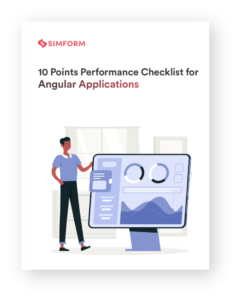
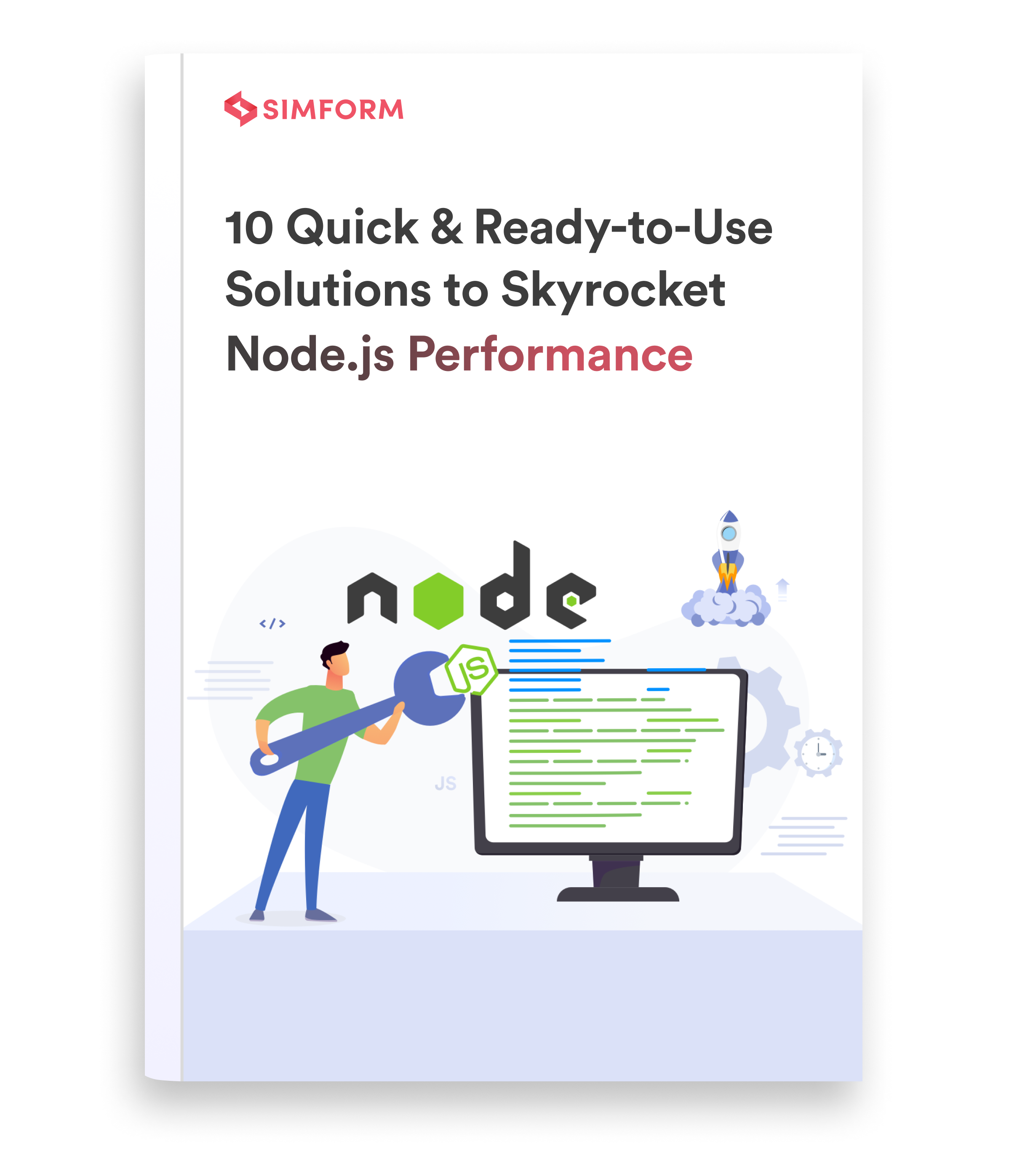
Venessa Serrao
Thanks for pondering. It's nice to see how the community is growing and such helpful articles are now easily accessible.
Venessa Serrao
Thank you, for yet another intuitive article. Reading your articles makes me feel up to date with the testing world. Plus it's nice to see how easily you managed to explain this and come across clear and straight to the point while keeping it fun!
Mykhailo
Nice Article BRO